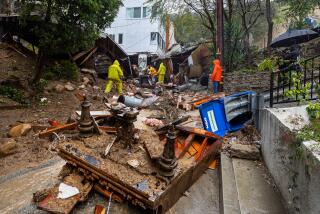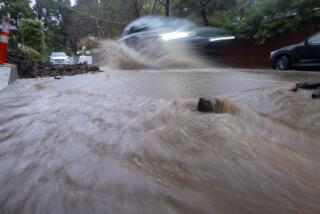Getting There Safely--Some Wet Roads Advice
- Share via
During wet weather, driving becomes hazardous--especially in California where both drivers and the terrain are unused to pounding rain.
But accidents and damage to automobiles can be avoided with a few precautions, experts say. Here are some tips:
* Do everything slowly and smoothly. Awkward movements--whether steering, hitting brakes or the gas--can force a wedge of water between tire treads and the road. Wheels become surfboards and cars tend to hydroplane. Jamming brakes or the gas pedal when turning, will cause back wheels to lock or spin and send the rear of the car sliding to the outside of the turn.
* Make sure your tires have enough tread. Bald tires induce hydroplaning, as do underinflated tires.
* Should you feel your car starting to stall, try to get it to the right shoulder. You’ll be out of traffic and able to get out of the vehicle.
* If you don’t know the depth of water, don’t try driving through it. Water at headlight level should be considered too high to go through. But if you do go through bumper-high water, go through slowly with even gas pedal pressure. Some people try to charge through, but that creates a wave that raises the water level and floods engines.
Remember, experts say, that a radiator fan will spray water over plugs and short out a vehicle’s ignition system. Also, some vehicles have engine air-intakes at bumper levels that will pull water into carburetors and eventually stall engines.
* Tap brakes to generate a little heat for drying out soggy brake drums, discs and pads.
* Keep wipers working full speed and windshield defrosters going full blast. And have a dry towel handy to wipe off the side windows.
* Keep your lights on and drive slowly. And, better still, don’t drive at all if you don’t have to.
More to Read
Sign up for The Wild
We’ll help you find the best places to hike, bike and run, as well as the perfect silent spots for meditation and yoga.
You may occasionally receive promotional content from the Los Angeles Times.






